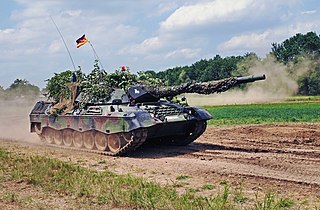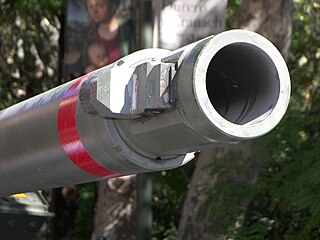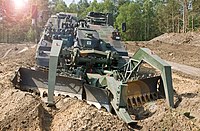
A military engineering vehicle is a vehicle built for construction work or for the transportation of combat engineers on the battlefield. These vehicles may be modified civilian equipment or purpose-built military vehicles. The first appearance of such vehicles coincided with the appearance of the first tanks, these vehicles were modified Mark V tanks for bridging and mine clearance. Modern military engineering vehicles are expected to fulfill numerous roles such as; bulldozer, crane, grader, excavator, dump truck, breaching vehicle, bridging vehicle, military ferry, amphibious crossing vehicle, and combat engineer section carrier.

The FV4034 Challenger 2 is a third generation British main battle tank (MBT) in service with the armies of the United Kingdom, Oman, and Ukraine.

The Kampfpanzer Leopard is a main battle tank designed by Porsche and manufactured by Krauss-Maffei in West Germany, first entering service in 1965. Developed in an era when HEAT warheads were thought to make conventional heavy armour of limited value, the Leopard design focused on effective firepower and mobility instead of heavy protection. It featured moderate armour, only effective against low caliber autocannons and heavy machine guns, giving it a high power-to-weight ratio. This, coupled with a modern suspension and drivetrain, gave the Leopard superior mobility and cross-country performance compared to most other main battle tanks of the era, only being rivaled by the French AMX-30 and Swedish Strv 103. The main armament of the Leopard consisted of a German license-built version of the British Royal Ordnance L7 105 mm rifled gun, one of the most effective and widespread tank guns of the era.

The Centurion was the primary British Army main battle tank of the post-World War II period. Introduced in 1945, it is widely considered to be one of the most successful post-war tank designs, remaining in production into the 1960s, and seeing combat into the 1980s. The chassis was adapted for several other roles, and these variants have remained in service. It was a very popular tank with good armour, mobility, and a powerful main armament.

The M728 Combat Engineer Vehicle (CEV) is a full-tracked vehicle used for breaching, obstacle removal, and pioneering operations. Production commenced in 1965 and ceased in 1987. A total of 312 of all variants of these armored engineer vehicles were produced.

The Leopard 2 is a third generation German main battle tank (MBT). Developed by Krauss-Maffei in the 1970s, the tank entered service in 1979 and replaced the earlier Leopard 1 as the main battle tank of the West German army. Various iterations of the Leopard 2 continue to be operated by the armed forces of Germany, as well as 13 other European countries, and several non-European countries, including Canada, Chile, Indonesia, and Singapore. Some operating countries have licensed the Leopard 2 design for local production and domestic development.

The Boxer is a multirole armoured fighting vehicle designed by an international consortium to accomplish a number of operations through the use of installable mission modules. The governments participating in the Boxer programme have changed as the programme has developed. The Boxer vehicle is produced by the ARTEC GmbH industrial group, and the programme is being managed by OCCAR. ARTEC GmbH is based in Munich; its parent companies are Krauss-Maffei Wegmann GmbH and Rheinmetall Military Vehicles GmbH on the German side, and Rheinmetall Defence Nederland B.V. for the Netherlands. Overall, Rheinmetall has a 64% stake in the joint venture.

The FV4201 Chieftain was the main battle tank (MBT) of the United Kingdom from the 1960s into 1990s. When introduced, it was among the most heavily armed MBTs of the era, mounting a 120 mm Royal Ordnance L11 gun, the equal of the much larger specialist heavy tanks then in service. It also was among the most heavily armoured, with up to 195 mm (7.7 in) that was highly sloped to offer 388 mm (15.3 in) thickness along the line of sight.

The Schützenpanzer Marder 1 is a tracked German infantry fighting vehicle designed for use with the West German Panzergrenadiere units, mechanized infantry specialized for IFV combat. It has been operated by the German Army as the main Panzergrenadiere IFV since the 1970s through to the present day. Developed as part of the rebuilding of West Germany's armoured fighting vehicle industry, the Marder has proven to be a successful and solid infantry fighting vehicle design.

The Royal Ordnance L7, officially designated Gun, 105 mm, Tank, L7, is the basic model of the United Kingdom's most successful tank gun. It is a 105 mm L/52 rifled design by the Royal Ordnance Factories, intended for use in armoured fighting vehicles, replacing the older QF 20-pounder (84 mm) gun mounted on the British Centurion tank. The successful L7 gun has been fitted on many armoured vehicles, including the Centurion, the German Leopard 1 and, in an altered design, as the M68 gun in several variants of the US M48 Patton and M60.

The TPz Fuchs from Transportpanzer Fuchs is a German armoured personnel carrier originally developed by Daimler-Benz, and manufactured and further developed by the now Rheinmetall MAN Military Vehicles (RMMV). Fuchs was the second wheeled armoured vehicle to enter service with the Bundeswehr. It can be used for tasks including troop transport, engineer transport, bomb disposal, Nuclear, Biological and Chemical reconnaissance and electronic warfare. RMMV and its predecessors manufactured 1,236 Fuchs 1, mostly for the German Army.

The Rheinmetall Rh-120 is a 120 mm smoothbore tank gun designed and produced in former West Germany by the Rheinmetall Waffe Munition GmbH company, it was developed in response to Soviet advances in armour technology and development of new armoured threats. Production began in 1974, with the first version of the gun, known as the L/44 as it was 44 calibres long, used on the German Leopard 2 tank and soon produced under license for the American M1A1 Abrams and other tanks. The 120-millimetre (4.7 in) gun has a length of 5.28 metres (17.3 ft), and the gun system weighs approximately 3,317 kilograms (7,313 lb).
The Henschel Wehrtechnik TH-200, TH-400, and TH-800 are a family of wheeled armoured fighting vehicles by Thyssen-Henschel. Their development was loosely related to the Spähpanzer Luchs.

The Rheinmetall LandSysteme Light Infantry Vehicle for Special Operations, or LIV (SO), is a German light armoured utility vehicle based on the Mercedes-Benz G-Class. It is also known by the names Serval, Wolf, and AGF. As the name implies, the LIV (SO) is designed specifically for use by special operations forces, and has light armour, high mobility and high firepower. Development of the vehicle started in 2002, and 21 were procured by the German Army for the KSK special forces in 2004. An unspecified number of vehicles were delivered to the Swiss Army in 2007.

Armoured Vehicle Royal Engineers (AVRE), also known as Assault Vehicle Royal Engineers, is the title given to a series of armoured military engineering vehicles operated by the Royal Engineers (RE) for the purpose of protecting engineers during frontline battlefield operations.

The Trojan Armoured Engineer Vehicle (AEV) is a combat engineering vehicle of the British Army. It is used to breach minefields and for many other tasks. It is currently in use with the Royal Engineers.

The IMR-2 is a Soviet and Russian tracked military engineering vehicle built on T-72 main battle tank chassis. IMR stands for Inzhenernaya Mashina Razgrazhdeniya, meaning "Clearing Engineering Vehicle".

The history and development of tanks in the Royal Canadian Armoured Corps can be broken down into smaller categories: their origin during World War I; the interwar period; World War II; the Cold War; and the modern era.

The Lynx is a German armoured fighting vehicle developed by Rheinmetall Landsysteme. The Lynx, configured as a KF31 infantry fighting vehicle (IFV), was unveiled at the Eurosatory defence exhibition on 14 June 2016. The KF41 variant was unveiled at the Eurosatory defence exhibition on 12 June 2018.

The Panther KF51 is a German main battle tank (MBT) that is under development by Rheinmetall Landsysteme. It was unveiled publicly at the Eurosatory defence exhibition on 13 June 2022.




























